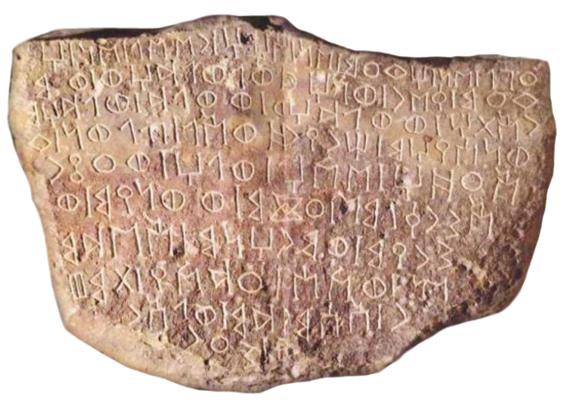In the Arabian Peninsula, ancient secrets of love and happiness engraved in stone |Arabnews Fr<
Mecca: old inscriptions on rocks throughout the Arabian peninsula help brush a painting of the first Arab cultures.They make it possible to better understand the economic and social conditions in which the populations of the time lived - and to learn more about their conception of love, marriage and happiness.
The engravings provide evidence of the first religious beliefs and ritual ceremonies, as well as details on the professions, crafts and local currencies, while emphasizing the professionalism and skill of the engravers, estimates Dr. Salma Hawsawi,Professor of Ancient History at the King Saud University of Riyadh.
"Writing is a human invention," said Hawsawi to Arab News."It is a way to exchange ideas and knowledge, as well as to discuss it within societies, regardless of class, beliefs and sects.»»»»»»»»»»»»»»»»»»»»»»»»»»»»»»»»
According to her, the historical information gleaned from these inscriptions could reflect the feelings of love, fear, nostalgia, sadness and happiness felt by the inhabitants at that time."These inscriptions are considered to be a real testimony of life during this historical period. Elles mettent en lumière la profondeur culturelle de la région»»»»»»»»»»»»»»»»»»»»»»»»»»»»»»»», explique-t-elle.
Hawsawi ensures that writing and engraving were considered as professions."Writing, in general, illustrates the level of civilization and education reached by Arab society, it is inseparable from the progress of humanity.»»»»»»»»»»»»»»»»»»»»»»»»»»»»»»»»
She specifies that the writing has developed in two stages."First there was a pre-alphabetical step, figurative writing, that is to say the representation of material things in the human environment to designate moral aspects through rock drawings.Then, the symbolic phase, with syllabic sounds.»»»»»»»»»»»»»»»»»»»»»»»»»»»»»»»»
According to Hawsawi, cuneiform writing has spread throughout Mesopotamia from around 3,200 BC.J-VS., and was used up to 100 AD.J-VS.

Hieroglyphic writing was used in Egypt around 4,000 BC.J.-VS., while Ugaritic writing was widespread in northern Syria.Sinaid writing dates back to 1400 BC.J-VS., and was invented by a group of Canaanites working in mines of turquoise and copper in the Sinai desert.
In addition, the Phoenician writing, which dates back to 1,000 BC.J-VS., and Punic writing have extended throughout North Africa from 300 BC.J-VS., and up to 300 apr.J-VS.
«L'existence de l'écriture dans les civilisations est la preuve de leur importance dans la codification, la communication et les relations entre les sociétés»»»»»»»»»»»»»»»»»»»»»»»»»»»»»»»», indique Hawsawi.
Throughout the Arabian Peninsula, written inscriptions offer indications on the Arab communities that lived in different regions.Some of these inscriptions had a religious character, focusing on the names of the gods and religious rituals.Others had a social dimension, dealing with personal status, marriage, divorce and surname.
The engravings have also provided details on the names and places of the tribes, as well as on professions and crafts, trade -related provisions, local currencies, exports and imports.
«Sur le plan politique, les inscriptions indiquaient les noms des rois et des souverains, les guerres ainsi que la naissance et la chute des États»»»»»»»»»»»»»»»»»»»»»»»»»»»»»»»», déclare-t-elle."These inscriptions are an important source of historical and cultural knowledge of the region.Their significant number gives us an idea of the level of knowledge and culture reached by societies, and the attention they led to writing and documentation.»»»»»»»»»»»»»»»»»»»»»»»»»»»»»»»»
Hawsawi specifies that the inscriptions could be on the rocks in an arranged or random manner, according to the person who wrote them, as well as on the facades of the temples, houses and even tombstones.Some represented the company in important events or the aphorisms of its leaders.
In the south of the peninsula, the writing of ancient South Arabia was used from around 800 BC.J-VS.Until 600 APR.J-VS.Inscriptions are very widespread and can be found on stones, wood and bones, in eastern Arabia, al-Faw, Najran and also in Aulla.
“Zabour writing also appeared in the south and dates back to around 500 BC.J-VS. Certains disent que l'ancienne écriture de l’Arabie du sud et l'écriture zabour sont apparues à peu près au même moment»»»»»»»»»»»»»»»»»»»»»»»»»»»»»»»», raconte la professeure d’histoire ancienne.
In the north of the Arabian Peninsula, Thamudic writing was used from 800 BC.J-VS., and consisted of 29 characters.Inscriptions have been found on rocky facades along the commercial road, from the far south to the far north of the Arab world.
Safaic writing is similar to Thamudic writing and dates back to the first century BC.J-VS.Dating from the ninth century, Aramaic writing has 22 letters, drawn from Phoenician writing, and is widely used in the ancient world, especially in Mesopotamia, Iran, India, Egypt and the north of the Arabian Peninsula.
Hawsawi underlines that “the scriptures dadanite and lihyanite date back to the viᵉ or vᵉ century BC.J-VS.And include 28 letters, some of which resemble the old Thamudic and southern Arabia writings.They are written from right to left, the words being separated by a vertical line.The Palmyrene and Syriac Scriptures from Aramaic date back to the first century BC.J-VS.Nabatean writing comes from Aramaic.However, some of his letters have changed shape and have been added a point, giving way to the Arabic writing that we use today.»»»»»»»»»»»»»»»»»»»»»»»»»»»»»»»»
The specialist indicates that writing in societies of the Arabian peninsula differs from that of other cultures because of its distinctive characters and the variety of themes. «La vie et les événements qui y sont associés ont été consignés, à la différence d'autres civilisations qui se sont concentrées sur la codification des événements politiques»»»»»»»»»»»»»»»»»»»»»»»»»»»»»»»», conclut-elle.
This text is the translation of an article published on Arabnews.com


 Tags:
Tags: Prev
Prev







